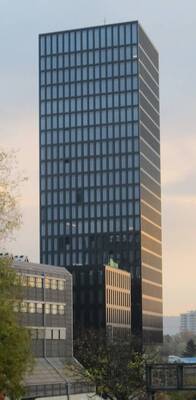The Grosspeter Tower in Basel serves three purposes at once: hotel, office block and power plant. The bottom five storeys form the plinth and are used as a hotel. This is topped with a seventeen-storey office tower. The façade is made up of a grid of generously sized windows and solar modules with a total power of 440 kilowatts, which capture the sun's energy to supply power to the building. The photovoltaic plants on the flat roofs of the plinth and the tower provide a further 100 kilowatts. This allows for 28 percent of the energy demand for the entire skyscraper to be met by solar power.
Utilising the façade for solar power presents particular challenges for the energy system technology. Around 450 types of variably sized thin-film modules were installed from the bottom to the top of Grosspeter Tower, over all elevations, covering an area of 5,000 square metres. Right from the outset, it was therefore necessary to account for the differing voltages of the modules. During operation, this situation is further complicated by the different amounts of solar radiation striking the four sides of the façade at any time. And in this tightly packed part of Basel, close to the station, the surrounding buildings also cast shadows on the solar arrays.
In order to obtain the highest possible energy yield under these conditions, the solar contractor for the project, Planeco GmbH from Münchenstein, called on the systems expertise of KACO new energy and the solar planning team from “energiebüro” in Zurich. “We addressed the varying module voltages using DC optimisers. These are distributed between a number of DC cabinets with remote-controlled DC switches on each floor and are each connected to several module strings. This creates an equalised voltage level. For safety reasons, we then make use of a total of five DC buses to transport the solar power to the mechanical room in the basement. A control system is also provided, which can de-energise individual floors or the entire plant,” says Georg Kress, project manager for KACO new energy.
A central inverter feeds the solar power to the service grid for the hotel and offices in the tower. The inverter also provides the necessary earthing for the thin-film modules. Data loggers keep the building services management updated as to the status of the solar power supply, and enable remote monitoring.
It is clear from the award of two separate prizes that the project effectively combines architecture and solar technology. On 6 October, the Grosspeter Tower received a Special Recognition Award as part of the “Architectural Award Building-Integrated Solar Technology 2017” organised by the “Solarenergieförderverein Bayern e.V.” (Bavarian Association for the Promotion of Solar Energy). In the “Prix Solaire Suisse 2017”, announced on 20 October, the solar tower won the award for Best New Building.
About KACO new energy:
KACO new energy, headquartered in Neckarsulm, Germany is one of the world’s largest manufacturers of inverters for grid-feed solar power. The product line-up covers the full power range, from single units designed for a family home up to complete systems for solar parks producing megawatts of electricity. Since 1999, KACO new energy has supplied inverters with a cumulative power output of 10 gigawatts. This offering has been extended to include solutions for PV self-consumption and energy storage, devices for grid management, as well as products and value-added services for utility-scale projects. KACO new energy is the first company in the photovoltaic industry to achieve CO2-neutral production and in 2014, celebrated the 100th birthday of the original parent company which, at the end of the 1930s, was one of first ever inverter manufacturers. More at www.kaco-newenergy.com


